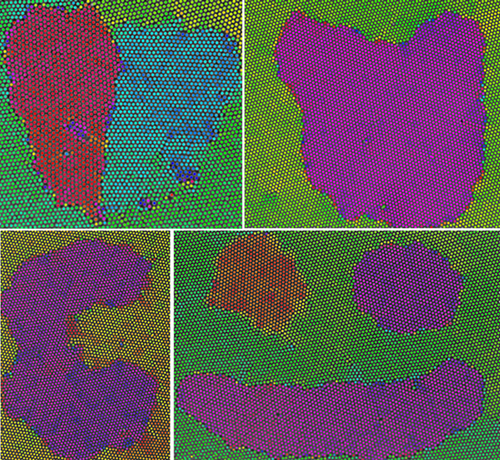How to Sculpt a Crystal
Many important materials such as steel are made up of a large number of small crystals—called crystallites or grains—and their sizes and shapes can affect the material’s properties. Now researchers have shown how to “sculpt” crystallites into any arbitrary shape, at least in a two-dimensional crystal made of tiny beads. The researchers found that the grain interfaces are malleable and tend to move toward a region that has been disturbed by a laser beam. The technique could lead to new ways of studying crystallites and to a new method for developing “designer” materials starting from microscopic structures.
The sizes and shapes of the crystallites that make up materials such as aluminum alloys and semiconductors can affect properties like strength and electrical conductivity. However, it’s difficult to study crystallites in detail in ordinary materials made of atoms, so researchers have resorted to colloids—systems where micrometer-sized spheres in a fluid play the role of atoms. Packing these tiny beads at high enough density between a pair of glass plates forms a triangular lattice in 2D, like thousands of racked billiard balls. However, the beads are usually not perfectly ordered; subregions tend to form with their axes aligned in different directions. Each of these regions is a grain separated from its neighbors by irregular boundaries. Researchers have studied these boundaries, for example, measuring their fluctuations or the ways that macroscopic forces affect them, but these researchers have never had complete control over the shapes of grains.
Sharon Gerbode and her colleagues at Harvey Mudd College in Claremont, California, developed a technique they call “optical blasting” to distort grain boundaries at will. A laser illuminating a several-micrometer-wide region of the colloid repels beads, creating a hole, and once the laser is turned off, the beads fill in the hole in a temporarily disordered or “melted” state. During the subsequent recrystallization of these beads, a nearby straight grain boundary will bow out as though it is attracted to the formerly illuminated zone.
The team observed this process in experiments and in computer simulations developed from textbook statistical mechanics. The explanation for the effect is based on understanding the constantly fluctuating shapes of grain boundaries. As the beads recrystallize following optical blasting, there are many possible shapes for a nearby grain boundary, and more of these configurations involve the boundary bowing-out than involve a straight boundary. This excess of configurations leads to the distorted boundary shape even though the increased boundary length requires additional energy. In other words, the system prefers to increase entropy than to lower its energy.
To demonstrate their complete control over grain boundaries, Gerbode and her colleagues created shapes including a smiley face, a heart, and a letter C. She says that since the basic effect comes from very general statistical mechanics, a similar technique ought to be applicable to materials made of atoms, potentially allowing researchers to design useful properties by shaping grains. For example, a layered grain structure could produce a material that is stiff in one direction but flexible in another.
In fact, modifying grains in order to improve material properties is an ancient tradition, going back to craftsmen who would repeatedly hammer on iron to strengthen it—a process later shown to work by reducing the sizes of crystallites. For centuries, “we’ve been doing this by banging on things,” says Gerbode, so her approach of “internally tuning” grains is a logical next step.
Soft matter physicist Eric Weeks of Emory University in Atlanta says that some researchers have previously melted colloidal crystals with light, and others have studied the fluctuations of grain boundaries. But Gerbode and her colleagues “put these together for a beautiful effect.” Weeks can imagine using the new technique in various ways to further study the behavior of grain boundaries. “The bottom line is that this is a great tool enabling a lot of fun future experiments,” he says.
This research is published in Physical Review Letters.
–David Ehrenstein
David Ehrenstein is a Senior Editor for Physics Magazine.





